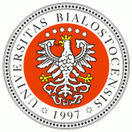Sponsors:



 |
|
Organized by
the Institute of Experimental Physics, University of Bialystok
Maciej Lorenc, France
Picosecond X-ray diffraction : "seeing is believing"
-
Third generation synchrotrons are high brilliance sources of X-ray radiation and their pulsed character (100 ps) has brought fascinating new possibilities, namely to fingerprint structures of molecules while they undergo reactions.
The chemistry in solution phase, which I will largely focus on in this lecture, is a very important field of research as it is a natural environment for the majority of life processes. Studying this environment with X-rays is ideal since X-rays can penetrate bulk samples and hence reveal the elementary principles driving chemical reactions. Because the atoms are so small (~10-10 m), and they take very little time to change positions (~10-13 s) their direct observation has eluded scientists for decades. This feat is now accomplished with the pump-probe method, where a "pump" laser triggers a reaction and a delayed "probe" pulse captures a snapshot of the transient species. Few experimental variants have been successfully developed to date: X-ray diffraction, X-ray absorption spectroscopy, or electron diffraction (gas phase, surfaces).
Technological innovations in synchrotron instrumentation and the development of novel data analysis have made it possible to track increasingly complex reactions in solution by time-resolved diffraction to a temporal and spatial resolution of 100 ps and 0.001 Å, respectively. For instance, the photodissociation reaction of C2H4I2 in methanol was recently investigated by this technique and the data analysis revealed a rather complex reaction pathway comprising a long purported bridged C2H4I radical, a linear isomer C2H4I-I, and the end-product C2H4 + I2. Moreover with TRXD, the properties and structures of elemental liquids can be studied too. I will illustrate on a common solvent how the use of TRXD can benefit the understanding of hydrodynamics on the acoustic horizon, and beyond. The liquids are disorderly, and consequently the three dimensions of molecular structures are reduced to one dimension of diffuse scattering pattern. This loss is compensated by a vital input from theoretical modelling, which allows calculation and then comparison with diffraction patterns. I will round off the lecture with examples from other fields in which TRXD has proved unmatched in visualising ephemeral structures. In particular, in certain molecular crystals isolated photoexcited molecules may couple before relaxing and cooperatively trigger macroscopic phase transitions. The fundamentally new mechanisms of non-thermal, possibly coherent, energy propagation in these solids are stirring debate and raise a formidable challenge for the years to come. TRXD already has, and will continue playing a part in disclosing new physics behind photo-induced ultrafast transitions. These efforts will be accompanied by femtosecond optical spectroscopy and emerging new X-ray sources (plasma generation, X-ray free electron laser).
|
|
|